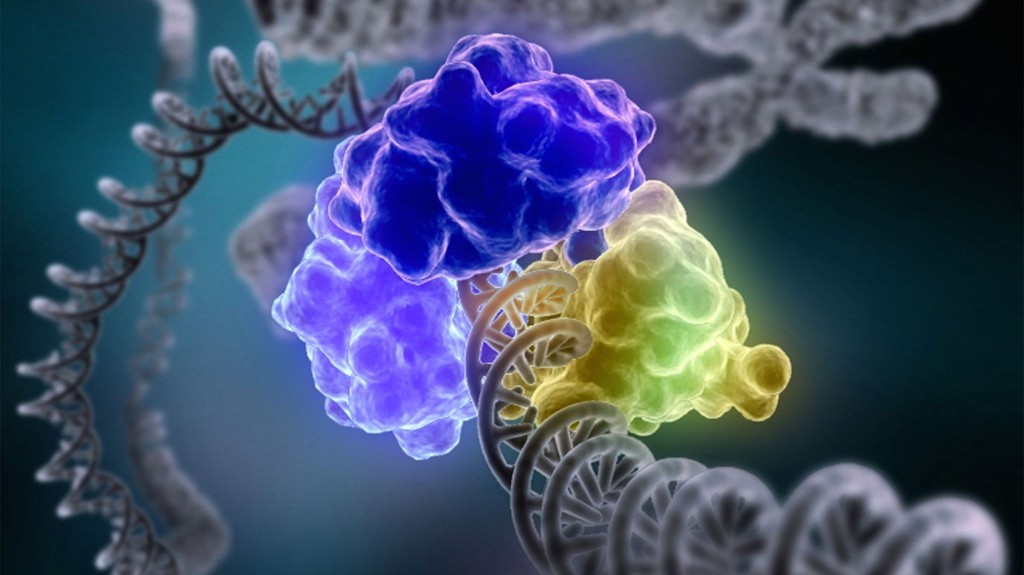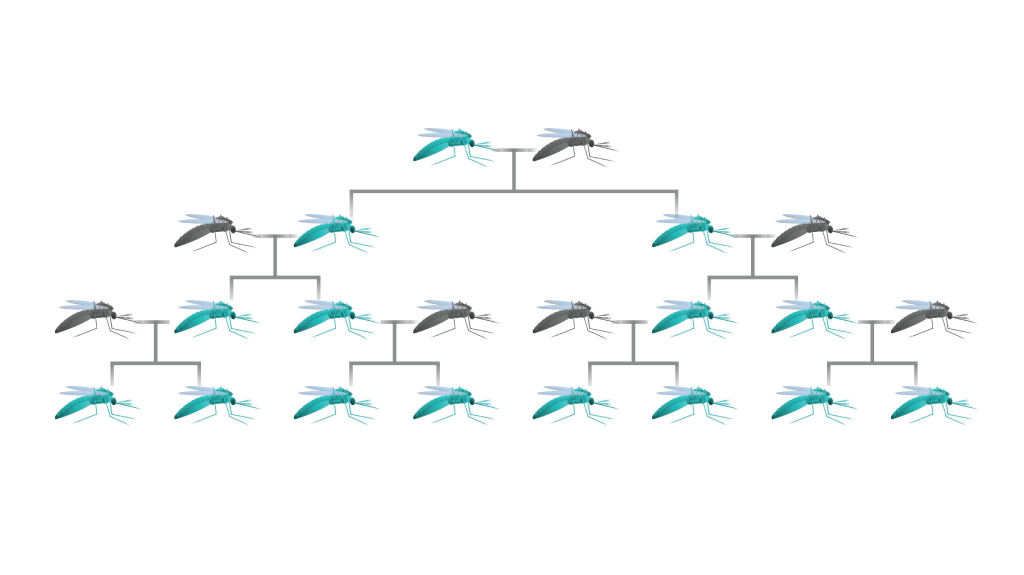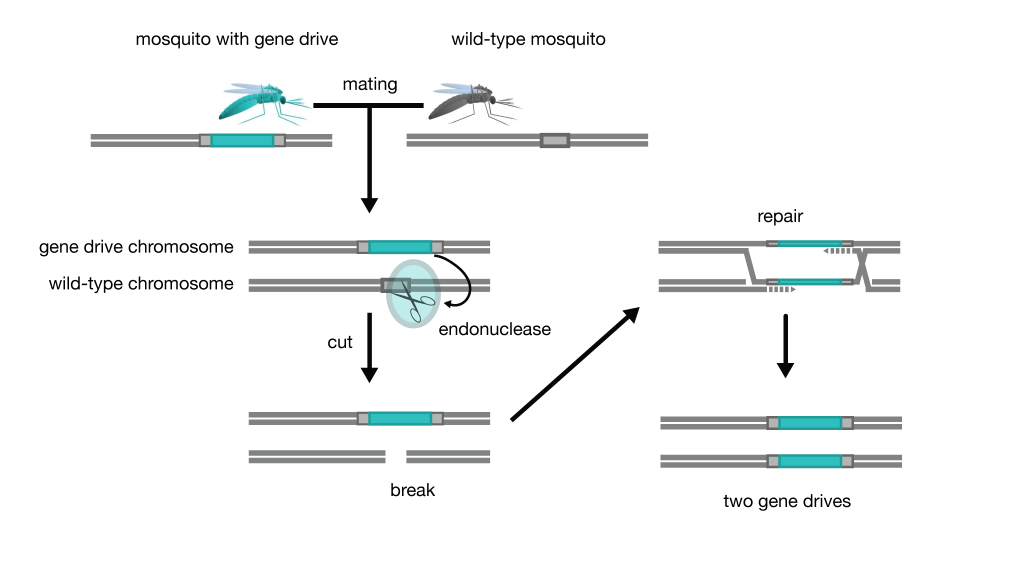http://www.pbs.org/wgbh/nova/next/evolution/crispr-gene-drives/
When it comes to genetic engineering, we’re amateurs. Sure, we’ve known about DNA’s structure for more than 60 years, we first sequenced every A, T, C, and G in our bodies more than a decade ago, and we’re becoming increasingly adept at modifying the genes of a growing number of organisms.
But compared with what’s coming next, all that will seem like child’s play. A new technology just announced today has the potential to wipe out diseases, turn back evolutionary clocks, and reengineer entire ecosystems, for better or worse. Because of how deeply this could affect us all, the scientists behind it want to start a discussion now, before all the pieces come together over the next few months or years. This is a scientific discovery being played out in real time.

Scientists have figured out how to use a cell's DNA repair mechanisms to spread traits throughout a population.
Today, researchers aren’t just dropping in new genes, they’re deftly adding, subtracting, and rewriting them using a series of tools that have become ever more versatile and easier to use. In the last few years, our ability to edit genomes has improved at a shockingly rapid clip. So rapid, in fact, that one of the easiest and most popular tools, known as CRISPR-Cas9, is just two years old. Researchers once spent months, even years, attempting to rewrite an organism’s DNA. Now they spend days.
Soon, though, scientists will begin combining gene editing with gene drives, so-called selfish genes that appear more frequently in offspring than normal genes, which have about a 50-50 chance of being passed on. With gene drives—so named because they drive a gene through a population—researchers just have to slip a new gene into a drive system and let nature take care of the rest. Subsequent generations of whatever species we choose to modify—frogs, weeds, mosquitoes—will have more and more individuals with that gene until, eventually, it’s everywhere.
Cas9-based gene drives could be one of the most powerful technologies ever discovered by humankind. “This is one of the most exciting confluences of different theoretical approaches in science I’ve ever seen,” says Arthur Caplan, a bioethicist at New York University. “It merges population genetics, genetic engineering, molecular genetics, into an unbelievably powerful tool.”
We’re not there yet, but we’re extraordinarily close. “Essentially, we have done all of the pieces, sometimes in the same relevant species.” says Kevin Esvelt, a postdoc at Harvard University and the wunderkind behind the new technology. “It’s just no one has put it all together.”
It’s only a matter of time, though. The field is progressing rapidly. “We could easily have laboratory tests within the next few months and then field tests not long after that,” says George Church, a professor at Harvard University and Esvelt’s advisor. “That’s if everybody thinks it’s a good idea.”
It’s likely not everyone will think this is a good idea. “There are clearly people who will object,” Caplan says. “I think the technique will be incredibly controversial.” Which is why Esvelt, Church, and their collaborators are publishing papers now, before the different parts of the puzzle have been assembled into a working whole.
“If we’re going to talk about it at all in advance, rather than in the past tense,” Church says, “now is the time.”
“Deleterious Genes”
The first organism Esvelt wants to modify is the malaria-carrying mosquito
Anopheles gambiae. While his approach is novel, the idea of controlling mosquito populations through genetic modification has actually been around since the late 1970s. Then, Edward F. Knipling, an entomologist with the U.S. Department of Agriculture, published a substantial handbook with a chapter titled “Use of Insects for Their Own Destruction.” One technique, he wrote, would be to modify certain individuals to carry “deleterious genes” that could be passed on generation after generation until they pervaded the entire population. It was an idea before its time. Kipling was on the right track, but he and his contemporaries lacked the tools to see it through.
The concept surfaced a few more times before being picked up by Austin Burt, an evolutionary biologist and population geneticist at Imperial College London. It was the late 1990s, and Burt was busy with his yeast cells, studying their so-called homing endonucleases, enzymes that facilitate the copying of genes that code for themselves. Self-perpetuating genes, if you will. “Through those studies, gradually, I became more and more familiar with endonucleases, and I came across the idea that you might be able to change them to recognize new sequences,” Burt recalls.
Other scientists were investigating endonucleases, too, but not in the way Burt was. “The people who were thinking along those lines, molecular biologists, were thinking about using these things for gene therapy,” Burt says. “My background in population biology led me to think about how they could be used to control populations that were particularly harmful.”
“There’s a lot to be done still, but on the scale of years, not months or decades.”
In 2003, Burt penned an influential article that set the course for an entire field: We should be using homing endonucleases, a type of gene drive, to modify malaria-carrying mosquitoes, he said, not ourselves. Burt saw two ways of going about it—one, modify a mosquito’s genome to make it less hospitable to malaria, and two, skew the sex ratio of mosquito populations so there are no females for the males to reproduce with. In the following years, Burt and his collaborators tested both in the lab and with computer models before they settled on sex ratio distortion. (Making mosquitoes less hospitable to malaria would likely be a stopgap measure at best; the
Plasmodium protozoans could evolve to cope with the genetic changes, just like they have evolved resistance to drugs.)
Burt has spent the last 11 years refining various endonucleases, playing with different scenarios of inheritance, and surveying people in malaria-infested regions. Now, he finally feels like he is closing in on his ultimate goal. “There’s a lot to be done still,” he says. “But on the scale of years, not months or decades.”
Cheating Natural Selection
Cas9-based gene drives could compress that timeline even further. One half of the equation—gene drives—are the literal driving force behind proposed population-scale genetic engineering projects. They essentially let us exploit evolution to force a desired gene into every individual of a species. “To anthropomorphize horribly, the goal of a gene is to spread itself as much as possible,” Esvelt says. “And in order to do that, it wants to cheat inheritance as thoroughly as it can.” Gene drives are that cheat.
Without gene drives, traits in genetically-engineered organisms released into the wild are vulnerable to dilution through natural selection. For organisms that have two parents and two sets of chromosomes (which includes humans, many plants, and most animals), traits typically have only a 50-50 chance of being inherited, give or take a few percent. Genes inserted by humans face those odds when it comes time to being passed on. But when it comes to survival in the wild, a genetically modified organism’s odds are often less than 50-50. Engineered traits may be beneficial to humans, but ultimately they tend to be detrimental to the organism without human assistance. Even some of the most painstakingly engineered transgenes will be gradually but inexorably eroded by natural selection.
Some naturally occurring genes, though, have over millions of years learned how to cheat the system, inflating their odds of being inherited. Burt’s “selfish” endonucleases are one example. They take advantage of the cell’s own repair machinery to ensure that they show up on both chromosomes in a pair, giving them better than 50-50 odds when it comes time to reproduce.

A gene drive (blue) always ends up in all offspring, even if only one parent has it. That means that, given enough generations, it will eventually spread through the entire population.
Here’s how it generally works. The term “gene drive” is fairly generic, describing a number of different systems, but one example involves genes that code for an endonuclease—an enzyme which acts like a pair of molecular scissors—sitting in the middle of a longer sequence of DNA that the endonculease is programmed to recognize. If one chromosome in a pair contains a gene drive but the other doesn’t, the endonuclease cuts the second chromosome’s DNA where the endonuclease code appears in the first.
The broken strands of DNA trigger the cell’s repair mechanisms. In certain species and circumstances, the cell unwittingly uses the first chromosome as a template to repair the second. The repair machinery, seeing the loose ends that bookend the gene drive sequence, thinks the middle part—the code for the endonuclease—is missing and copies it onto the broken chromosome. Now both chromosomes have the complete gene drive. The next time the cell divides, splitting its chromosomes between the two new cells, both new cells will end up with a copy of the gene drive, too. If the entire process works properly, the gene drive’s odds of inheritance aren’t 50%, but 100%.

Here, a mosquito with a gene drive (blue) mates with a mosquito without one (grey). In the offspring, one chromosome will have the drive. The endonuclease then slices into the drive-free DNA. When the strand gets repaired, the cell's machinery uses the drive chromosome as a template, unwittingly copying the drive into the break.
Most natural gene drives are picky about where on a strand of DNA they’ll cut, so they need to be modified if they’re to be useful for genetic engineering. For the last few years, geneticists have tried using genome-editing tools to build custom gene drives, but the process was laborious and expensive. With the discovery of CRISPR-Cas9 as a genome editing tool in 2012, though, that barrier evaporated. CRISPR is an ancient bacterial immune system which identifies the DNA of invading viruses and sends in an endonuclease, like Cas9, to chew it up. Researchers quickly realized that Cas9 could easily be reprogrammed to recognize nearly any sequence of DNA. All that’s needed is the right RNA sequence—easily ordered and shipped overnight—which Cas9 uses to search a strand of DNA for where to cut. This flexibility, Esvelt says, “lets us target, and therefore edit, pretty much anything we want.” And quickly.
Gene drives and Cas9 are each powerful on their own, but together they could significantly change biology. CRISRP-Cas9 allows researchers to edit genomes with unprecedented speed, and gene drives allow engineered genes to cheat the system, even if the altered gene weakens the organism. Simply by being coupled to a gene drive, an engineered gene can race throughout a population before it is weeded out. “Eventually, natural selection will win,” Esvelt says, but “gene drives just let us get ahead of the game.”
Beyond Mosquitoes
If there’s anywhere we could use a jump start, it’s in the fight against malaria. Each year, the disease kills over 200,000 people and sickens over 200 million more, most of whom are in Africa. The best new drugs we have to fight it are losing ground; the
Plasmodium parasite is evolving resistance too quickly. And we’re nowhere close to releasing an effective vaccine. The direct costs of treating the disease are estimated at $12 billion, and the economies of affected countries grew 1.3% less per year, a substantial amount.
Which is why Esvelt and Burt are both so intently focused on the disease. “If we target the mosquito, we don’t have to face resistance on the parasite itself. The idea is, we can just take out the vector and stop all transmission. It might even lead to eradication,” Esvelt says.
Esvelt initially mulled over the idea of building Cas9-based gene drives in mosquitoes to do just that. He took the idea to to Flaminia Catteruccia, a professor who studies malaria at the Harvard School of Public Health, and the two grew increasingly certain that such a system would not only work, but work well. As their discussions progressed, though, Esvelt realized they were “missing the forest for the trees.” Controlling malaria-carrying mosquitoes was just the start. Cas9-based gene drives were the real breakthrough. “If it let’s us do this for mosquitos, what is to stop us from potentially doing it for almost anything that is sexually reproducing?” he realized.
“What is to stop us from potentially doing it for almost anything that is sexually reproducing?”
In theory, nothing. But in reality, the system works best on fast-reproducing species, Esvelt says. Short generation times allow the trait to spread throughout a population more quickly. Mosquitoes are a perfect test case. If everything were to work perfectly, deleterious traits could sweep through populations of malaria-carrying mosquitoes in as few as five years, wiping them off the map.
Other noxious species could be candidates, too. Certain invasive species, like mosquitoes in Hawaii or Asian carp in the Great Lakes, could be targeted with Cas9-based gene drives to either reduce their numbers or eliminate them completely. Agricultural weeds like horseweed that have evolved resistance to glyphosate, a herbicide that is broken down quickly in the soil, could have their susceptibility to the compound reintroduced, enabling more farmers to adopt no-till practices, which help conserve topsoil. And in the more distant future, Esvelt says, weeds could even be engineered to introduce vulnerabilities to completely benign substances, eliminating the need for toxic pesticides. The possibilities seem endless.
The Decision
Before any of that can happen, though, Esvelt and Church are adamant that the public help decide whether the research should move forward. “What we have here is potentially a general tool for altering wild populations,” Esvelt says. “We really want to make sure that we proceed down this path—if we decide to proceed down this path—as safely and responsibly as possible.”
To kickstart the conversation, they partnered with the MIT political scientist Kenneth Oye and others to convene a series of workshops on the technology. “I thought it might be useful to get into the room people with slightly different material interests,” Oye says, so they invited regulators, nonprofits, companies, and environmental groups. The idea, he says, was to get people to meet several times, to gain trust and before “decisions harden.” Despite the diverse viewpoints, Oye says there was surprising agreement among participants about what the important outstanding questions were.
As the discussion enters the public sphere, tensions are certain to intensify. “I don’t care if it’s a weed or a blight, people still are going to say this is way too massive a genetic engineering project,” Caplan says. “Secondly, it’s altering things that are inherited, and that’s always been a bright line for genetic engineering.” Safety, too, will undoubtedly be a concern. As the power of a tool increases, so does its potential for catastrophe, and Cas9-based gene drives could be extraordinarily powerful.
There’s also little in the way of precedent that we can use as a guide. Our experience with genetically modified foods would seem to be a good place to start, but they are relatively niche organisms that are heavily dependent on water and fertilizer. It’s pretty easy to keep them contained to a field. Not so with wild organisms; their potential to spread isn’t as limited.
There’s little in the way of precedent that we can use as a guide.
Aware of this, Esvelt and his colleagues are proposing a number of safeguards, including reversal drives that can undo earlier engineered genes. “We need to really make sure those work if we’re proposing to build a drive that is intended to modify a wild population,” Esvelt says.
There are still other possible hurdles to surmount—lab-grown mosquitoes may not interbreed with wild ones, for example—but given how close this technology is to prime time, Caplan suggests researchers hew to a few initial ethical guidelines. One, use species that are detrimental to human health and don’t appear to fill a unique niche in the wild. (Malaria-carrying mosquitoes seem fit that description.) Two, do as much work as possible using computer models. And three, researchers should continue to be transparent about their progress, as they have been. “I think the whole thing is hugely exciting,” Caplan says. “But the time to really get cracking on the legal/ethical infrastructure for this technology is right now.”
Church agrees, though he’s also optimistic about the potential for Cas9-based gene drives. “I think we need to be cautious with all new technologies, especially all new technologies that are messing with nature in some way or another. But there’s also a risk of doing nothing,” Church says. “We have a population of 7 billion people. You have to deal with the environmental consequences of that.”
http://www.pbs.org/wgbh/nova/next/evolution/crispr-gene-drives/





